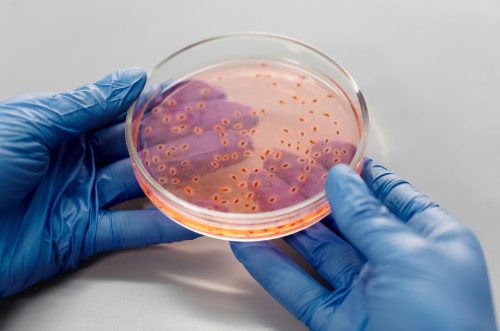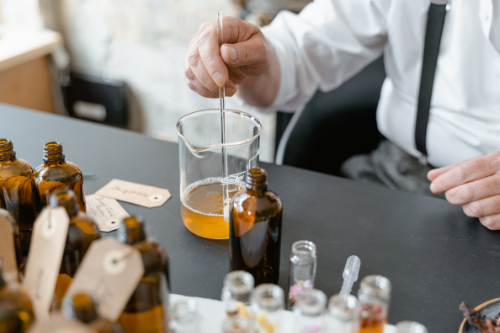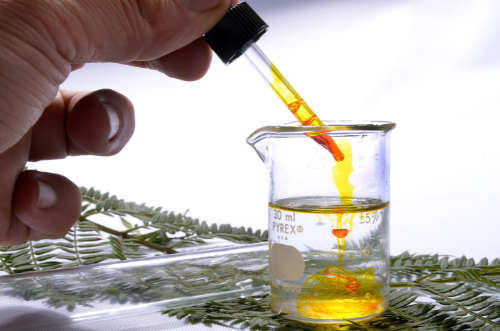In today’s cosmetic landscape, consumers seek more than just efficacy: they demand science, personalisation, and sustainability. In this context, ingredients such as postbiotics, enzymes, and ferments are emerging as undisputed protagonists. Far from being a passing trend, they represent a paradigm shift towards smarter, more biotechnological cosmetics that respect the cutaneous microbiota. This article delves deep into the role of these new-generation actives, their impact on 2025 trends, and how to strategically integrate them into a skincare line with the support of an OEM laboratory.
What are postbiotics, enzymes, and ferments? Key definitions
In this section, we discuss the value of these ingredients in cosmetic formulation, going beyond their definitions. Each one not only provides direct benefits to the skin but also transforms the way modern cosmetic products are designed, contributing to formulas that are more stable, effective, and sensorially appealing.
Postbiotics
Postbiotics are bioactive metabolites derived from the fermentation of probiotic microorganisms. Unlike probiotics (live microorganisms), postbiotics do not contain viable organisms, which makes them more stable and safer in cosmetic formulations. Among them are short-chain fatty acids, peptides, polysaccharides, and enzymes, which modulate the cutaneous microbiome and strengthen the skin barrier.
In cosmetic formulation, postbiotics stand out for their high compatibility with other actives, their resistance to changes in temperature and pH, and their ease of integration into different formats: from creams and lotions to toners, serums, or even facial cleansing products. They do not require special storage conditions, unlike live probiotics, which makes them ideal for shelf-stable, mass-market products.
From a technical perspective, they act as bioactivators that improve barrier function, stimulate ceramide synthesis, and can modulate the skin’s inflammatory response. Their application extends to anti-ageing ranges, soothing products, dermo-cosmetics for sensitive skin, or for conditions such as atopic dermatitis or rosacea.
Clinical studies have shown that certain postbiotics can reduce dermal inflammation, improve barrier function recovery after damage, and contribute to more resilient skin. Ingredients such as postbiotic lactic acid or fermented bacterial lysates are finding their place in high-end and medical-grade cosmetic products.
Enzymes
Enzymes are catalytic proteins that accelerate biochemical reactions. In cosmetics, enzymes such as papain, bromelain, or lipases are used for their exfoliating, anti-inflammatory, or sebum-regulating properties. They enable gentle cellular renewal whilst respecting sensitive or compromised skin.
In terms of formulation, enzymes allow for the replacement of traditional mechanical or acidic exfoliants, reducing the irritative potential of a product. Additionally, they can be incorporated into formulations with neutral pH, making them compatible with more unstable or sensitive active ingredients. They are ideal for “free from” ranges (acid-free, fragrance-free, alcohol-free) and are highly valued in natural or dermatological cosmetics.
They also have an interesting role as adjuvants in detox formulas or double cleansing products, improving the elimination of cellular debris and helping other actives to penetrate more effectively. Some enzymes even exhibit selective antimicrobial properties, useful for formulations intended for acne-prone skin.
Unlike traditional chemical exfoliants such as AHAs, enzymes act solely on the layer of dead cells without affecting the living layers of the epidermis. This makes them ideal allies for sensitised, ageing, or irritation-prone skin, providing smoothness, radiance, and uniformity without side effects.
Ferments
Ferments (or fermented ingredients) are obtained through biotechnological processes in which microorganisms such as yeasts or bacteria transform compounds into substances with greater bioavailability. Fermentation enhances the efficacy of plant extracts, improves the penetration of actives, and provides antioxidant, moisturising, or soothing properties.
In formulation, ferments allow for the enrichment of a formula with bioactive peptides, amino acids, and polysaccharides that would not be available in their natural state. Additionally, they reduce the molecular weight of ingredients, facilitating their absorption even in skin with weakened barrier function. This makes them key allies in anti-ageing, depigmenting, or regenerating formulas.
Their technical versatility allows for their inclusion in both water-based products and emulsions. Many ferments improve the stability of the final product by acting as chelating agents, mild preservatives, or sensory enhancers. Moreover, they integrate well with natural preservatives, which is essential in green or eco-friendly formulations.
A popular example is Galactomyces Ferment Filtrate, widely used in Korean cosmetics, known for its ability to brighten the skin, reduce visible pores, and balance sebum production. Additionally, fermented ingredients such as rice, centella asiatica, or ginseng have shown superior anti-inflammatory and regenerative effects compared to their non-fermented counterparts.

Comparative Table: Prebiotics, Probiotics and Postbiotics
| Ingredient Type | Definition | Biological State | Cosmetic Application | Stability in Formulations |
|---|---|---|---|---|
| Prebiotics | Fibres or nutrients that feed beneficial microorganisms | Non-living | Strengthen the microbiota | High |
| Probiotics | Living microorganisms with beneficial effects | Living | Rebalance the skin flora | Low |
| Postbiotics | Metabolites derived from microorganisms | Non-living | Strengthen the skin barrier and reduce inflammation | Very high |
This distinction is crucial when formulating products: live probiotics require advanced encapsulation or cold preservation technologies, whilst postbiotics allow greater technical freedom and durability without compromising efficacy.
Cosmetic Trends 2025: Why These Ingredients Are Key
In 2025, cosmetic trends revolve around biotechnology, holistic skin care, and microbiome integrity. Consumers prefer products that respect skin physiology, avoid harsh ingredients, and deliver measurable results backed by evidence.
- Microbiome-friendly cosmetics: Interest in maintaining the balance of skin flora has driven the use of postbiotics and ferments that do not alter skin biodiversity. Searches for ingredients such as lactobacillus ferment have increased by 120% on trend platforms like WGSN and Mintel. This approach has ceased to be exclusive to niche brands and has extended to dermatological lines and supermarket cosmetics.
- Increase in sensitive and reactive skin: Factors such as environmental stress, urban pollution, mask use (maskne), or aggressive treatments (such as poorly formulated exfoliating acids) have deteriorated the skin barrier of many consumers. In this context, products formulated with gentle enzymes and anti-inflammatory postbiotics position themselves as an effective solution to restore skin homeostasis. Lines focused on reactive skin and rosacea are integrating these actives as standard practice, not as an exception.
- Scientific and personalised approach: The era of personalised cosmetics is consolidating thanks to advances in diagnostic technology: DNA tests, microbiome scans, and sebum or hydration analyses are being used to recommend bespoke products. Fermented actives, postbiotics, and specific enzymes enable the development of formulas that respond to individual parameters, reinforcing consumers’ perception of value and innovation.
- Technical naturalness: New generations of consumers demand “clean” yet effective products. Ingredients such as plant ferments, extracted through biotechnological processes and without chemical solvents, enable green and effective formulation, aligning with demands for sustainability and environmental respect. This technical naturalness also reduces impact on ecosystems and minimises the use of artificial preservatives.
- Ethical biotechnology: Fermentation as a production process enables the replacement of animal-derived ingredients with plant-based or synthetic equivalents, without compromising functionality. This drives the growth of vegan, clean beauty, and cruelty-free lines, which already represent approximately 30% of new cosmetic launches in Europe and North America. This approach also improves brands’ sustainability profile with certification bodies and in export processes.
- Intelligent multifunctionality: Another key pillar of 2025 trends is the development of formulations that combine multiple benefits in a single product. Ingredients such as postbiotics not only improve the skin barrier but also possess antioxidant, soothing, and reparative properties. Enzymes can exfoliate, reduce inflammation, and stimulate cellular regeneration. Ferments, meanwhile, enhance the absorption of actives, deeply hydrate, and improve the overall texture of the skin. This multifunctionality facilitates simplified routines, highly valued by consumers with fast-paced lifestyles.
Ultimately, biotechnological ingredients such as postbiotics, enzymes and ferments are no longer a future trend, but a consolidated reality that will continue to shape cosmetic development in the coming years. Brands that successfully incorporate these actives with a technical, responsible and differentiated approach will be better positioned to lead the next generation of skincare.
Specific benefits by skin type
The use of postbiotics, enzymes and ferments can be optimised when tailored to the characteristics and needs of each skin type. Below are detailed specific benefits and suggested applications according to different skin profiles.
Acne-prone skin
Postbiotics: reduce C. acnes proliferation, regulate inflammation and balance the microbiota.
Enzymes: such as papain or bromelain, gently remove dead cells without altering pH or the lipid barrier.
Ferments: such as rice or galactomyces ferment, help with healing and reduce post-inflammatory hyperpigmentation.
Formulation example: Purifying cleansing gel with papain, lactobacillus ferment and zinc PCA.
Sensitive skin or rosacea-prone skin
Postbiotics: such as bacterial lysates, help strengthen the skin barrier, calm reactivity and reduce redness.
Enzymes: offer an alternative to exfoliating acids, removing impurities without irritation.
Ferments: from centella asiatica or oats, provide soothing and anti-inflammatory properties.
Formulation example: Soothing moisturising cream with oat ferment, panthenol and postbiotics.
Mature skin
Postbiotics: stimulate peptide synthesis and improve epidermal density.
Enzymes: promote cellular renewal, reducing fine lines and improving texture.
Ferments: such as ginseng or green tea ferment, are potent antioxidants and boost collagen production.
Formulation example: Anti-ageing serum with ginseng ferment, hyaluronic acid and papaya enzymes.
Combination skin
Postbiotics: help balance oily and dry areas without disrupting the skin ecosystem.
Enzymes: allow selective exfoliation without overstimulating sebum production.
Ferments: regulate shine and provide light hydration in dehydrated areas.
Formulation example: Balancing mask with bamboo ferment, papain and niacinamide.
Dehydrated skin
Postbiotics: restore barrier function and improve water retention.
Enzymes: remove the layer of dead cells that prevents absorption of moisturising actives.
Ferments: such as lactobacillus or yeast, strengthen natural moisture and reduce transepidermal water loss.
Formulation example: Rehydrating toner with rice ferment, pumpkin enzyme and betaine.
These next-generation actives not only enable the creation of more effective products, but also make them more specific, safer and more distinctive. Their correct selection and combination may be key to resolving complex skin problems without resorting to formulations
How to integrate these ingredients into your cosmetics line with the technical support of a cosmetic OEM

Incorporating postbiotics, enzymes, and ferments into a cosmetics line requires not only an innovative vision, but also the technical and regulatory backing of a specialised OEM laboratory such as MS Lab. Below, we break down how to carry out this integration in an effective, coherent, and strategic manner.
1. Diagnosis and definition of the approach
The first step is to define the aim of the line: to treat sensitive skin? to develop an anti-acne range? to focus on microbiome-friendly or anti-ageing cosmetics? A good OEM supports this stage with trend analysis, review of approved ingredients, and benchmarking studies.
2. Personalised selection of actives
An OEM laboratory can suggest combinations of ferments, postbiotics, and enzymes tailored to the brand’s identity. For example:
For a brand focused on sensitive skin: Lactobacillus lysate + oat ferment + pumpkin enzyme.
For a men’s detox range: ginseng ferment + papaya enzyme + lipidic postbiotic.
The laboratory’s technical team will also be able to assess compatibility between these actives and other ingredients such as preservatives, emollients, or sunscreens.
3. Development of stable and effective formulas
One of the main contributions of the OEM is controlling the stability of the formula, ensuring that the actives remain functional throughout the product’s shelf life. In the case of ferments or enzymes, the ideal pH, type of emulsion, compatible preservative system, and synergies between actives are all assessed.
MS Lab, for example, works with validation protocols that include:
Accelerated stability tests
Antimicrobial challenge test
Packaging compatibility tests
4. Technical and differentiating storytelling
An OEM laboratory also assists in building the brand’s narrative, making it possible to communicate the technical benefits clearly and accessibly. This includes claim proposals, ingredient storytelling, graphic support for social media, and advice on legislation (such as the limits on the use of the term “probiotic” in cosmetics depending on the region).
Example of storytelling:
“Our range is formulated with advanced biotechnology that combines rice ferments and plant enzymes to strengthen the skin barrier, restore microbiome balance, and visibly improve skin texture in 14 days.”
5. Regulatory compliance and industrial scaling up
The laboratory is responsible for ensuring compliance with local and international regulations (such as the EU, FDA, or Mercosur), as well as overseeing the process of scaling up to industrial production, packaging, and logistics.
Incorporating next-generation ingredients such as postbiotics, enzymes, and ferments not only enhances product efficacy but also conveys innovation, sustainability, and scientific backing. With adequate support, it is possible to create a high-impact cosmetic range, tailored to the needs of the modern consumer and the demands of the global market.
Conclusion
Postbiotics, enzymes, and ferments represent both the present and future of skincare. Incorporating them is not just a technical decision, but a statement of principles in the face of an increasingly informed, discerning, and conscious consumer. These ingredients not only elevate the performance of a formula, but also reinforce brand identity and positioning in a highly competitive market.
At MS Lab, we have the infrastructure, scientific team, and expertise in advanced formulation to help you transform these trends into concrete, stable products ready to scale up to market. Our OEM approach covers everything from ideation to regulatory development, guaranteeing quality, innovation, and real differentiation.
Are you ready to create a cosmetic range backed by biotechnology with proven results?
Contact us and let’s begin designing the future of your brand together.




